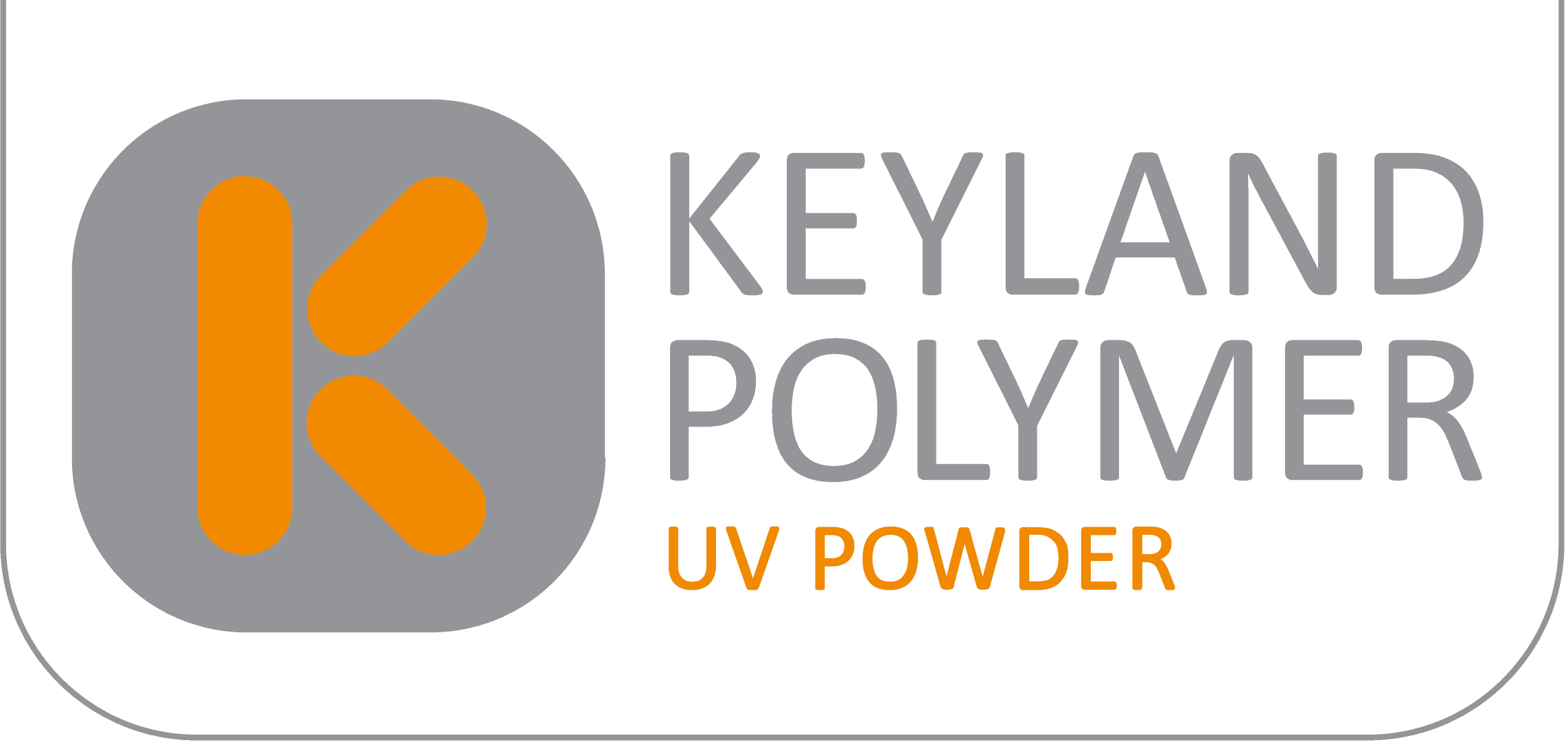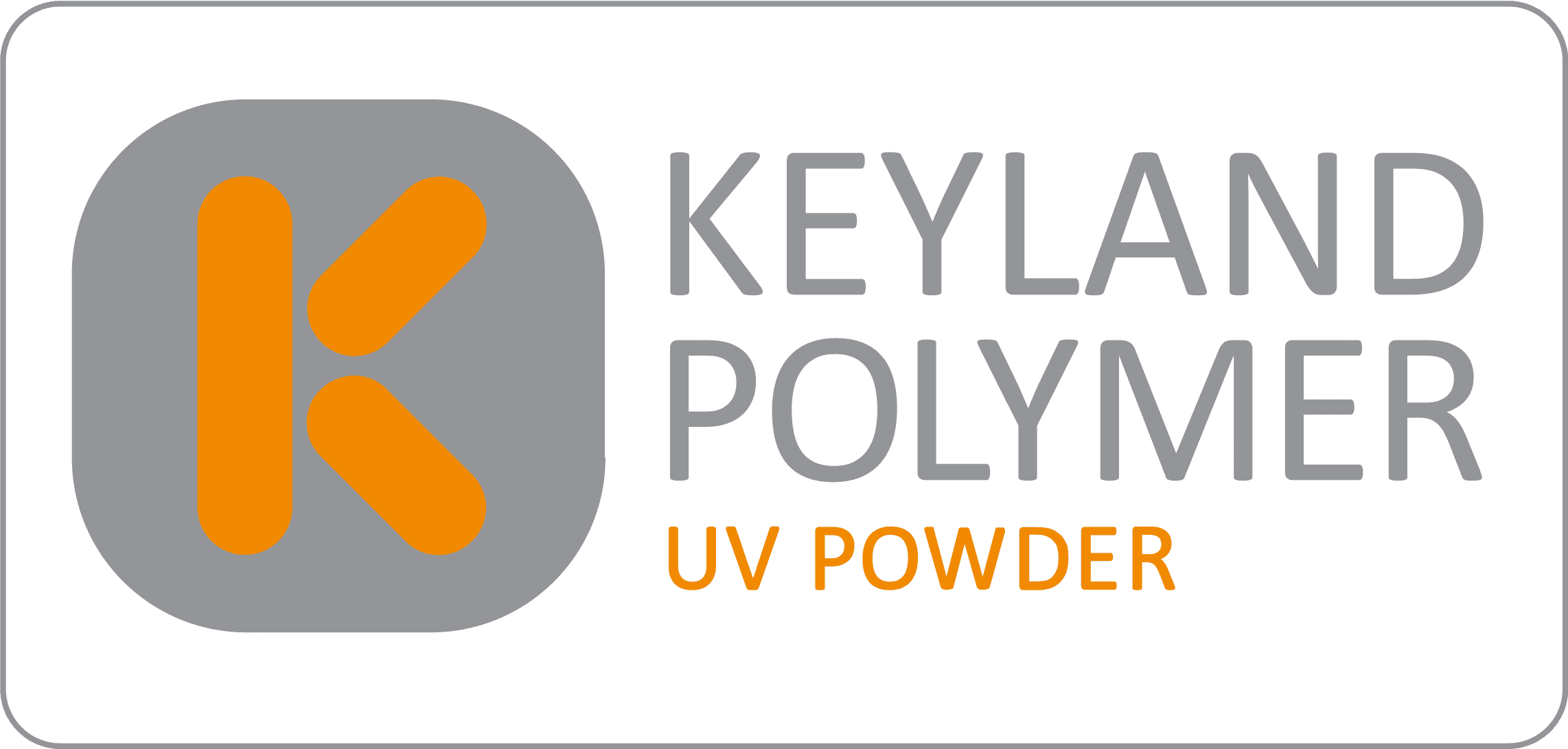Technical Data
UV Cured Powder Coatings on Metal
| Application Data | ||
|---|---|---|
| Application | Powder is typically sprayed using corona electrostatic spray guns. | |
| Melt | Melt times will range from 1-4 minutes depending on metal thickness, part size, oven set temperatures and type of oven. | |
| UV Cure | It is recommended that UV powder coatings be cured using gallium-doped lamps with a UV-V dosage of 2000-4000 mJ/cm2 and UV-V intensity of 1000-2000 mW/cm2. A coating temperature of 110-140°C (230-284°F) is recommended at the time of cure. | |
| UV LED Cure | Unpigmented and pigmented powder coatings will cure using a UV LED lamp under the correct parameters. Contact Keyland Polymer for product and process information. | |
| Storage and Shelf Life | Dry and cool conditions below 18°C (65°F) for 6 months are recommended for storage stability. Contact Keyland Polymer to confirm the appropriate storage conditions for your product. | |
| Technical Properties | ||||
| Gloss | ASTM D 523 | 3-95 GU @60° | ||
| Adhesion | ASTM D 3359, Method B | 4B Minimum | ||
| Pencil Hardness | ASTM D 3363 | H – 4H | ||
| Impact Resistance | ASTM D 2794 | 15-160+ in. -lbs Direct 15-160+ in. -lbs Indirect | ||
| Abrasion Resistance | ASTM D 4060 CS-17 Wheel, 500g, 500 cycles | 10 – 35 mg material loss | ||
| Conical Mandrel | ASTM D 552 | 1/8″ Mandrel No Cracking | ||
| Salt Spray | ASTM B 117 | 1000 Hours Pass <1/8″ Scribe Creep No Blisters | ||
Film properties were determined using 1.7-2.3 mils (43-58 μm) powder film over pretreated iron phosphated, chrome rinsed, 22-gauge, unpolished cold rolled steel test panels. Impact was determined at 2.0 mils.
Revision 1 March 2023
UV Cured Powder Coatings on Plastics and Composites
| Application Data | ||
|---|---|---|
| Application | Powder is typically sprayed using corona electrostatic spray guns. Most plastic materials and some carbon fiber materials require use of a conductive aid to allow for electrostatic transfer. Contact Keyland Polymer for more information. | |
| Melt | Melt times will range from 0.5-3 minutes depending on polymer base, part size/ dimensions, oven set temperatures, and type of oven. | |
| UV Cure | It is recommended that UV powder coatings be cured using gallium-doped lamps with a UVV dosage of 2000-4000 mJ/cm2 and UVV intensity of 1000-2000 mW/cm2. A coating temperature of 105-140°C (221-284ᵒF) is recommended at the time of cure. | |
| UV LED Cure | Unpigmented and pigmented powder coatings will cure using a UV LED lamp under the correct parameters. Contact Keyland Polymer for product and process information. | |
| Storage and Shelf Life | Dry and cool conditions below 18°C (65ᵒF) for 6 months are recommended for storage stability. Contact Keyland Polymer to confirm the appropriate storage conditions for your product. | |
| Technical Properties | ||||
| Gloss | ASTM D 523 | 3-90 GU @60° | ||
| Adhesion | ASTM D 3359, Method B | 4B Minimum | ||
| Pencil Hardness | ASTM D 3363 | H – 4H | ||
| Abrasion Resistance | ASTM D 4060 CS-17 wheel, 500 g, 1000 cycles | 10 – 35 mg material loss | ||
Film properties were determined by averaging test results from a variety of common polymer and carbon fiber substrates at 1.8-2.5 mils (46-64 µm) powder film thickness.
Revision 1 March 2023
UV Cured Powder Coatings on Wood
| Application Data | ||
|---|---|---|
| Application | Powder is typically sprayed using corona electrostatic spray guns. Preheating of MDF should be kept to a minimum to reach recommended surface temperature of 60-70°C (140-158°F), typically 1-2 minutes. | |
| Melt | Melt times will range from 1-3 minutes depending on MDF thickness, part size, oven set temperatures and type of oven. | |
| UV Cure | It is recommended that opaque powder coatings be cured using gallium-doped lamps with a UV-V dosage of 2000-4000 mJ/cm2 and UV-V intensity of 1000-2000 mW/cm2. A coating temperature of 100-130°C (212-266°F) is recommended at the time of cure. | |
| UV LED Cure | Unpigmented and pigmented powder coatings will cure using a UV LED lamp under the correct parameters. Contact Keyland Polymer for product and process information. | |
| Storage and Shelf Life | Dry and cool conditions below 18°C (65°F) for 6 months are recommended for storage stability. Contact Keyland Polymer to confirm the appropriate storage conditions for your product. | |
| Technical Properties | ||||
| 60° Gloss | ASTM D 523 | 3 – 90 | ||
| Film Build | ASTM D 4138, Method A Destructive, Tooke Gauge | 3 – 5 mils | ||
| Adhesion | ASTM D 3359, Method A- (X-Scribe | 4A Minimum | ||
| Pencil Hardness | ASTM D 3363 | H – 4H | ||
| Impact | NEMA LD 3-2005, Test Method 3.8 | 35-60+ in. minimum, no cracking | ||
| Abrasion Resistance | ASTM D 4060, CS-17 Wheel, 500g, 1000 cycles | 10 – 35 mg material loss | ||
| Boiling Water Resistance | NEMA LD 3-2005, Test Method 3.5 | No blistering | ||
Revision 1 March 2023


